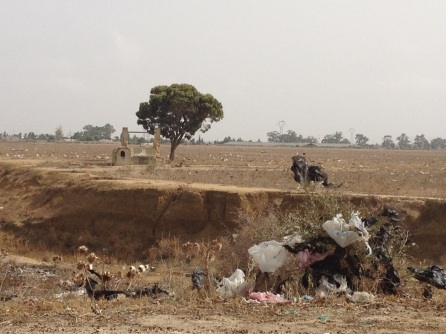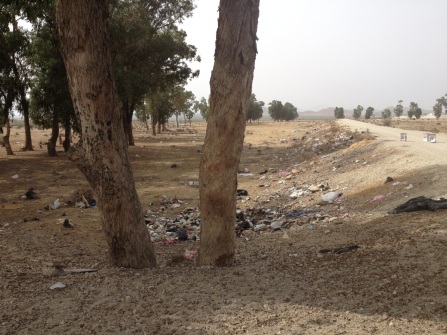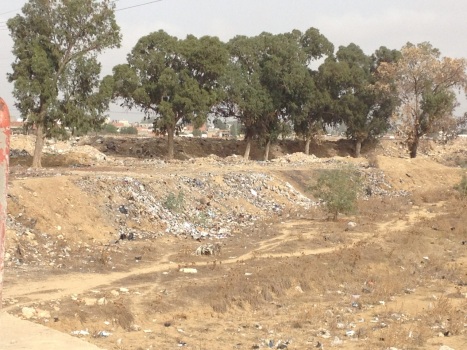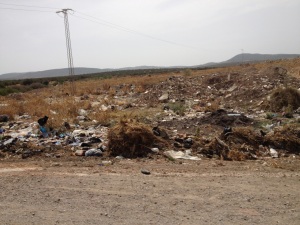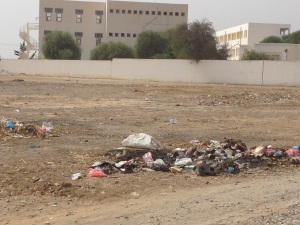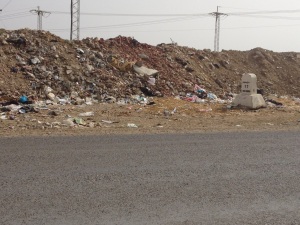(Hi, We’re in France now, but I got behind on my posts, so I’m trying to catch up this week)
It is not possible to write about Tunisia without talking about garbage. You see it as soon as you leave the airport. There is a enormous pile of garbage beside the road, which all our driver said was because of the poorest neighborhood right beside it. Still, the poorest neighborhood doesn’t explain the plastic bags caught in trees 70 km away, or the dry riverbeds with tributaries of blue plastic water bottles and plastic, or chancres of construction waste.
These photos were all taken out the car window so please forgive their quality. I think they give an idea of what we saw.
It’s in the sea, too. I swim every day over plastic bottles, cans, rope, strips of plastic, and one day, the rebar frame of a beach umbrella. One day I swam over a low spot on the bottom where two ripped soccer balls, a soda bottle and a condom were collected. Floating plastic outnumbers jellyfish about twenty to one. When the kids dig in the sand at our beach, they use the sieve toy to sift the cigarette butts and bottle lids out first. Even so, when they dig down they find diapers, chicken bones and more butts. Once, in Sousse, I had to dodge a full garbage bag in the enormous waves. When the sun lights the waves from behind, you can see the garbage silhouetted like a rolling kaleidoscope of crap.
In Sousse we accidentally went to the local beach instead of the tourist beach (the difference is the level of development on the street facing the beach, and that there is no beach garbage collection tractor that drives the high tide line, scooping up garbage each day). I had to cross a thick line of water bottle lids, plastic bags and labels, the ubiquitous butts, water-worn tiles and beverage cans to get to the water. Tayo chose this beach to spend an hour measuring distances with cartwheels, and I winced inwardly the entire time. It was gross. But she was having fun, and sometimes the rest of us enjoy time to be silent together.
One day while swimming my route I swam into the equivalent of an oil slick of plastic. The wind and currents must have brought it in, because it was only there for one day. It looked like the ocean might if you wanted to make a documentary about garbage but needed to fake it up a bit to make it look good on film. It was utterly over the top. Every 2 feet was a plastic bag, and there were ribbons of plastic dangling from the surface like sea grass after a storm. Mixed in were smaller bits of plastic, from palm to fingernail size. I tried to dive deep and swim under the garbage, but the plastic bits were everywhere. It took four breaths of hard swimming to get through.
Besides how ugly it looks, plastic in the sea causes problems for wildlife. Sea turtles can mistake plastic bags for jellyfish (it certainly took my startle reflex a long time to differentiate between them). And there are leatherback turtles in Tunisia, though they are rare. After it’s been in the water a while, plastic photo-degrades in the sunlight and breaks down into smaller pieces. These smaller pieces can be eaten by fish and other animals and begin to work through the food chain. When the pieces become smaller than 5mm, they are called micro-plastics, and they begin to enter the food chain through the filter-feeders, such as clams and microorganisms. There is a fair bit of research on the effects of micro-plastics on ocean ecology. Plastic Busters are actively researching this summer, and MED, (Mediterrranean EnDangered).
In Tunisia, there are several organizations working on this. In May of this year, Let’s Do It! organized a Mediterranean clean up, with divers and beach combers in many countries going out to collect garbage in and around the water.
I met a Tunisian man who lives in Scotland now, and he said the garbage problem is both cultural and political. Earlier this year, the garbage collectors were on strike for several months for higher wages. He also said that people are uneducated and just throw their garbage wherever. However, we often saw overflowing garbage bins. There’s not much point putting garbage in an overfull bin.
Our observations only led to more questions. Is the problem really individual behavior? We noticed there is no recycling, and we wondered what factors go into a government setting up a recycling program. Would recycling reduce the garbage everywhere? Were the shallow pits beside the road with bulldozers official dump sites or private solutions to a big problem? Why are the river valleys a magnet for dumping? Will it all wash away in the rainy season?
The Tunisian citizenry is also taking action. There is a Facebook group which began in May of this year called SelfiePoubella. Tunisians are invited to take a selfie with the garbage in their neighborhoods in an attempt to bring attention to this issue and shame the government into action. Read about it here in Global Voices.

